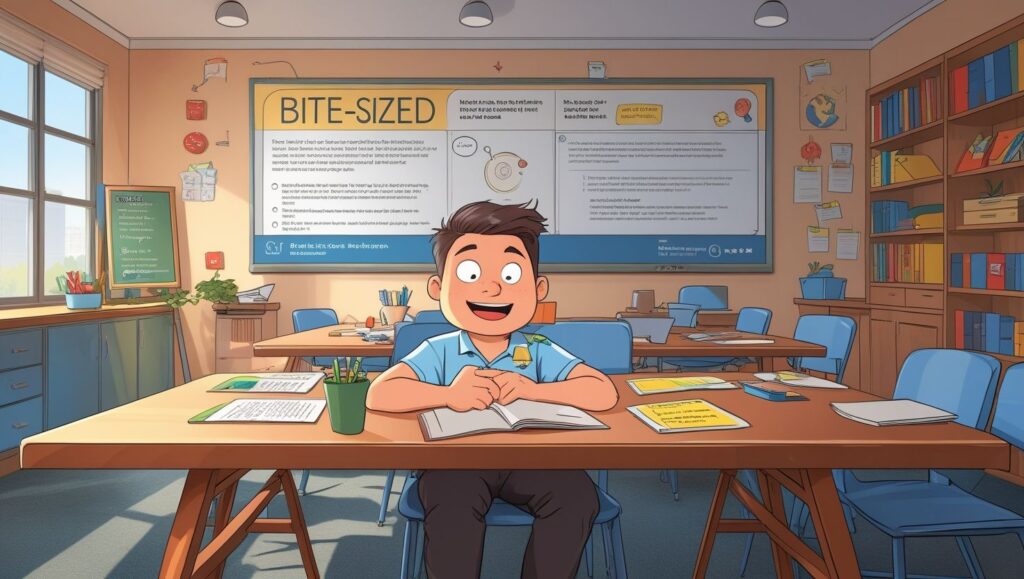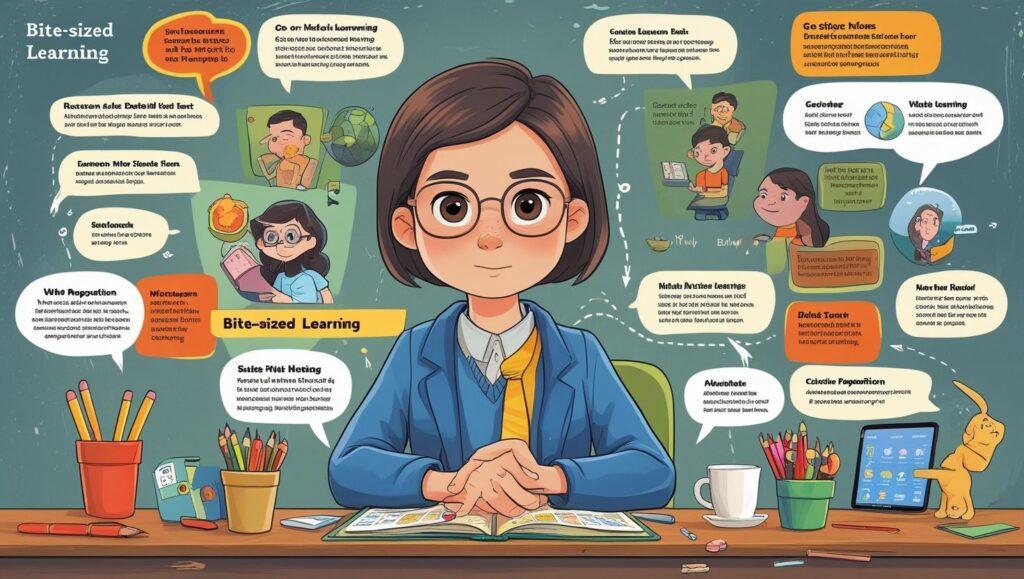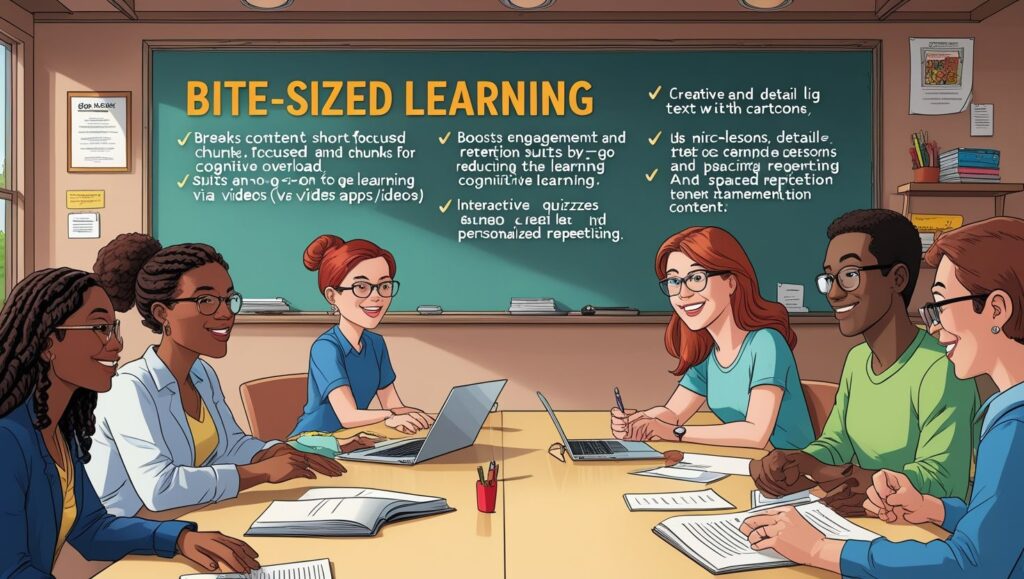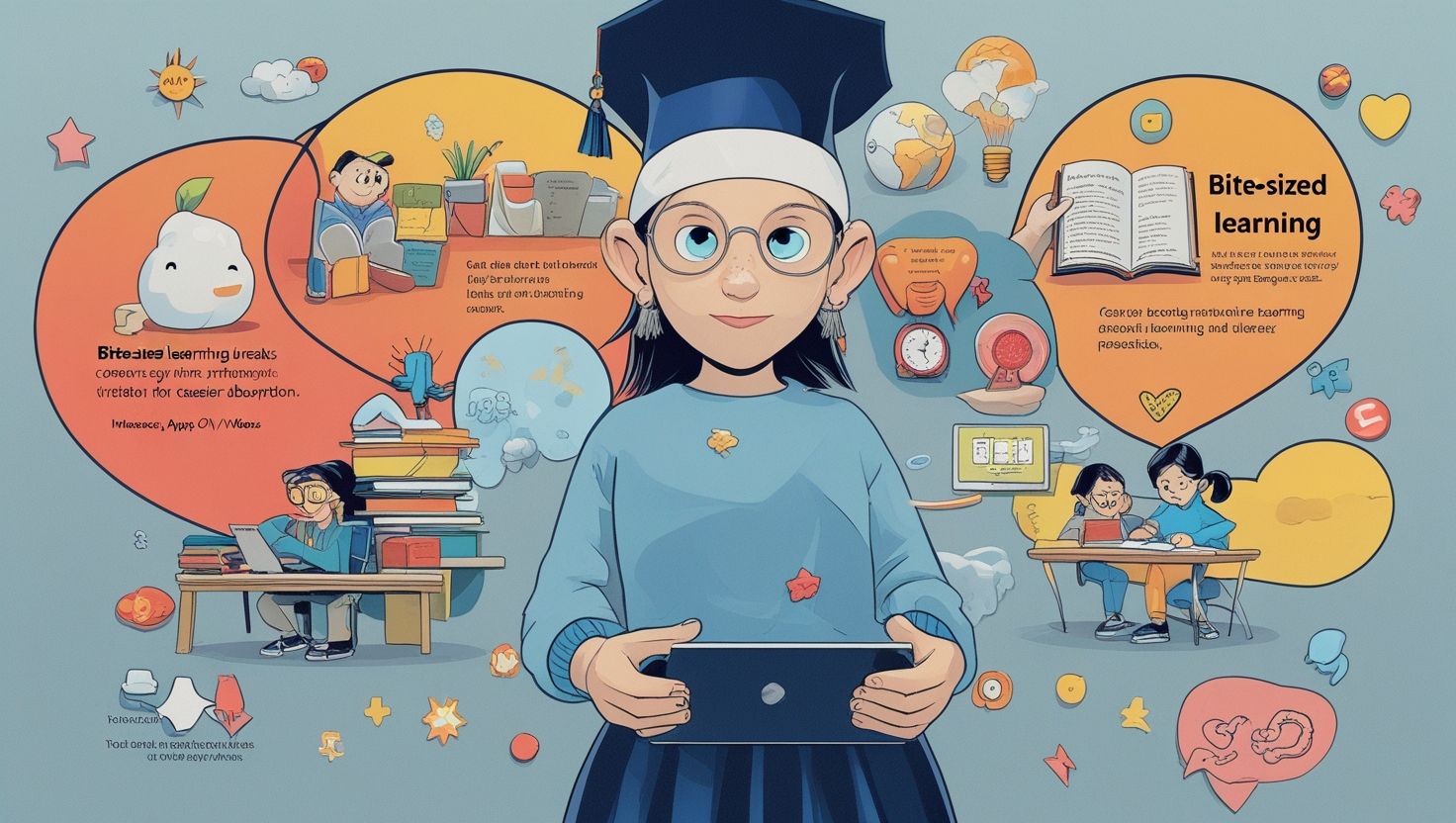1. Introduction
Bite-Sized Learning in Education, Education has evolved significantly over the past few decades. While traditional teaching methods focused on lengthy lectures, modern approaches prioritize learner engagement. One such approach is bite-sized learning. As the name suggests, bite-sized learning breaks content into small, manageable parts. Each module covers only one specific concept. It is also known as microlearning.
This method has gained popularity due to its adaptability and flexibility. Not only does it support fast-paced lifestyles, but it also fits the modern attention span. Furthermore, students can absorb information better when presented in shorter sessions. Because of these advantages, schools and institutions are increasingly adopting it.
Moreover, bite-sized learning is suitable for both online and offline environments. Teachers can deliver content through videos, slides, quizzes, or short readings. Learners, on the other hand, can review them quickly and easily. Additionally, this method supports self-paced learning. Therefore, students feel less overwhelmed.
In addition, bite-sized learning aligns well with cognitive theories. It promotes retention and encourages repetition. As a result, learners can revise and master skills effectively. Thus, the appeal of microlearning continues to grow. Clearly, it is transforming how knowledge is delivered in modern classrooms.
2. Historical Evolution and Rise of Microlearning
Although the term “bite-sized learning” is relatively new, the idea is not. Historically, educators have always tried to simplify complex ideas. However, the rise of technology has made microlearning more structured and accessible. In earlier times, oral traditions often used small units of wisdom—such as fables or proverbs—to educate.
With the arrival of formal education, long lessons became the norm. Yet, research revealed that learners often struggled with attention and retention. Consequently, educators began exploring alternative formats. Over time, shorter modules were introduced. Additionally, e-learning platforms began to experiment with micro-content.
Eventually, the digital revolution changed everything. With smartphones and online access, content could now be delivered in seconds. Apps and platforms started providing lessons in 5 to 10-minute sessions. Therefore, learning became more flexible than ever before.
Moreover, studies showed that learners retained more when content was broken into smaller parts. This led to a surge in interest among educational institutions. Today, bite-sized learning is widely used in schools, universities, and corporate training. It continues to evolve as technology improves.
Clearly, its rise is not accidental. It reflects the changing needs of learners in a fast-paced world. As education modernizes, microlearning is becoming a central feature.

3. Core Principles of Bite-Sized Learning
Bite-sized learning is based on several core principles. Firstly, brevity is crucial. Each lesson should focus on just one topic or skill. This allows learners to absorb information without feeling overloaded. Secondly, clarity matters. Since time is limited, the content must be precise and well-structured.
Another key principle is engagement. Because learners have short attention spans, lessons must be interactive and stimulating. Videos, games, flashcards, or visuals often replace long readings. Moreover, accessibility is also important. Content should be easy to access on any device, at any time. This supports just-in-time learning.
In addition, repetition and reinforcement are critical. Since each unit is short, students are encouraged to revisit them often. As a result, memory retention improves. Furthermore, modularity is essential. Lessons are designed as standalone units but can also be linked together.
Equally important is personalization. Learners can choose which micro-units suit their current needs. This builds autonomy and improves motivation. Moreover, feedback is integrated into the system. Short quizzes or instant assessments help students reflect.
Therefore, bite-sized learning is not just about shrinking lessons. It’s about thoughtful design, meaningful content, and learner-centered experiences. These principles ensure its effectiveness in various educational settings.
4. Benefits for Student Learning and Retention
Bite-sized learning offers multiple benefits for students. First and foremost, it improves retention. When content is divided into small, digestible parts, the brain processes it more efficiently. Therefore, learners remember it better. In contrast, lengthy lectures often result in fatigue and forgetfulness.
Additionally, bite-sized content supports spaced repetition. This means that students can revisit lessons frequently. As a result, knowledge becomes more permanent. Furthermore, learners are more likely to stay motivated. Because tasks are short, they feel easier to complete. Each successful completion boosts confidence.
Moreover, students experience less stress. Instead of cramming, they learn gradually. This reduces anxiety and promotes deeper understanding. Also, bite-sized modules fit into busy schedules. Learners can study in between activities—on the bus, during breaks, or at home.
Another advantage is self-paced learning. Students progress based on their needs. If a topic is challenging, they can spend more time. If it’s familiar, they can move quickly. In addition, microlearning is inclusive. It caters to diverse learners, including those with attention or learning difficulties.
Clearly, this method enhances both comprehension and enjoyment. It makes education more accessible and personalized. Thus, bite-sized learning helps students perform better in both the short and long term.

5. Impact on Teachers and Instructional Design
Bite-sized learning doesn’t just benefit students. It also transforms how teachers design and deliver lessons. Traditionally, educators planned lengthy lectures covering multiple topics. However, this often led to information overload. With microlearning, instruction becomes more focused and efficient.
Teachers can now create content with clear learning goals. Each module addresses one skill or concept. Therefore, it is easier to evaluate student progress. Furthermore, teachers can use a variety of formats—such as videos, infographics, or quizzes. This adds creativity to teaching and keeps learners engaged.
Additionally, lesson planning becomes more flexible. Educators can mix and match modules based on student needs. If a student struggles with a topic, the teacher can assign extra micro-lessons. Conversely, for advanced learners, enrichment content can be provided.
Moreover, bite-sized learning allows for quick feedback. Teachers can use digital tools to track performance in real time. This helps them adjust strategies accordingly. It also supports flipped classrooms. Students study the micro-units at home and then discuss them in class.
Despite some challenges in preparation, teachers find this method effective. It saves time in the long run and supports deeper learning. Clearly, instructional design improves when educators embrace microlearning techniques.
6. Integration in Digital Learning Platforms
Digital platforms play a major role in implementing bite-sized learning. Because of the rise of smartphones and internet access, microlearning is now easier than ever. Platforms such as Khan Academy, Duolingo, and Coursera use bite-sized modules effectively. These tools offer short videos, quizzes, and readings tailored to learner needs.
In addition, Learning Management Systems (LMS) like Moodle and Google Classroom support micro-content. Teachers can upload small lessons and track progress. Students can complete tasks at their own pace. Moreover, these systems often provide analytics. Therefore, both students and teachers receive feedback.
Furthermore, gamification features—such as badges, leaderboards, and rewards—boost engagement. Learners are more likely to complete tasks when they see quick results. Also, mobile apps allow learning to happen anywhere. Whether it’s five minutes during lunch or ten minutes before sleep, every moment counts.
Another benefit is personalization. Algorithms can recommend lessons based on performance. This ensures that students focus on what they need most. Clearly, digital tools are perfect companions for bite-sized learning. While challenges like internet access still exist, the advantages outweigh the drawbacks. With proper integration, digital platforms can revolutionize the learning experience using microlearning.
7. Role in Inclusive and Special Education
Bite-sized learning also plays a significant role in inclusive education. Students with learning disabilities or attention disorders often struggle with traditional formats. Long lessons can be overwhelming. In contrast, microlearning provides short, focused content that is easier to digest.
For instance, children with ADHD benefit from brief, engaging tasks. Since each lesson requires minimal attention span, they stay more focused. Furthermore, repetition and multimedia support help those with dyslexia or processing delays. Therefore, bite-sized modules are more adaptable to individual needs.
In addition, the format supports various learning styles. Visual learners benefit from images and videos. Auditory learners can listen to short podcasts. Kinesthetic learners can engage with interactive content. As a result, inclusivity is enhanced. Moreover, bite-sized learning encourages independence. Students take control of their learning pace. They feel less dependent on constant teacher support. This builds confidence and self-efficacy.
Teachers can also customize modules. Based on the student’s Individualized Education Program (IEP), content can be adjusted. Progress can be tracked easily, and feedback can be instant. Clearly, microlearning supports educational equity. It provides tools and strategies that make learning accessible for all. This inclusive approach ensures no learner is left behind.

8. Challenges and Limitations of Bite-Sized Learning
Despite its many benefits, bite-sized learning has certain limitations. One major concern is the risk of oversimplification. Sometimes, complex concepts require deeper exploration. Micro-units may not provide enough depth. As a result, learners might miss important details or context.
Moreover, creating effective micro-content takes time and expertise. Teachers need training in instructional design. Without it, the lessons may lack structure or coherence. Also, assessments must align with the small lessons. Otherwise, it becomes difficult to measure understanding accurately.
Another challenge is the loss of continuity. Since topics are broken into fragments, students might fail to see the bigger picture. Therefore, teachers must ensure that modules are well-connected. Proper sequencing is necessary to avoid confusion.
In addition, some learners may over-rely on quick content. They may skip critical thinking or reflection. Furthermore, not all subjects suit microlearning. For instance, literature analysis or philosophy may need longer discussion formats.
Technology issues can also arise. Students without reliable internet may face barriers. Therefore, schools must ensure equitable access to digital tools. In conclusion, bite-sized learning is not a one-size-fits-all solution. While highly effective in many cases, it must be applied thoughtfully and in balance with other methods.
9. Future of Education and Bite-Sized Learning
The future of education is increasingly shaped by digital trends and learner needs. Bite-sized learning is likely to remain a key element of modern education. As attention spans shorten and demands on learners grow, shorter modules provide much-needed flexibility.
Moreover, artificial intelligence will enhance microlearning. Smart systems can tailor content based on individual progress. If a learner struggles with a concept, AI can recommend additional micro-units. In turn, learning becomes more personalized and efficient.
Additionally, virtual reality and augmented reality may be used to deliver immersive bite-sized lessons. Imagine exploring the solar system in five-minute virtual segments. This makes learning more engaging and memorable.
Incorporating real-world scenarios in short modules also enhances relevance. For example, financial literacy or life skills can be taught through micro-videos. This prepares learners for practical challenges beyond school.
Furthermore, corporate training already uses microlearning effectively. As students enter the workforce, they will expect similar methods. Therefore, educational institutions must adapt to this shift.
However, the focus should remain on quality. Regardless of format, content must remain meaningful. Thus, a blended approach combining microlearning with in-depth study may become the norm. Clearly, bite-sized learning will continue to shape the future of education in powerful ways.
10. Conclusion:
Bite-sized learning represents a powerful shift in educational philosophy. By breaking complex subjects into manageable parts, it makes learning more accessible, enjoyable, and effective. It aligns well with today’s fast-paced world and modern learner needs.
From improving retention to boosting engagement, microlearning offers many benefits. Students feel less stressed, more in control, and better motivated. Teachers, in turn, find new ways to innovate and personalize instruction. Furthermore, digital platforms and inclusive strategies expand its reach.
Nevertheless, it is not without limitations. Oversimplification, content fragmentation, and technological barriers are real concerns. However, with thoughtful design and balanced integration, these challenges can be managed. Ultimately, education must evolve. As attention spans decrease and content demands increase, bite-sized learning provides a practical solution. It helps students master skills, build confidence, and become lifelong learners.
Schools, educators, and policymakers should embrace this model. By blending microlearning with traditional methods, they can create richer, more dynamic learning experiences. Clearly, bite-sized learning is not just a trend—it is a future-ready strategy. As we move forward, it is time to make learning more human-centered, efficient, and empowering. Bite-sized learning brings us one step closer to that vision.

Your advice is exactly what I needed right now.
This is exactly the kind of content I’ve been searching for.
I love the clarity in your writing.
Thanks for addressing this topic—it’s so important.
Your advice is exactly what I needed right now.
This was a great reminder for me. Thanks for posting.
Great points, well supported by facts and logic.
This gave me a whole new perspective on something I thought I already understood. Great explanation and flow!
This made me rethink some of my assumptions. Really valuable post.
You explained it in such a relatable way. Well done!
I hadn’t considered this angle before. It’s refreshing!
I wasn’t sure what to expect at first, but this turned out to be surprisingly useful. Thanks for taking the time to put this together.
Thanks for making this so reader-friendly.
Thank you for sharing this! I really enjoyed reading your perspective.
It’s great to see platforms prioritizing transparency & fairness – crucial for healthy gaming! The idea of blockchain-backed systems, like with okking99 slot, is exciting. Building trust through verification (KYC) is a smart move for a safe experience.
1mhbvs
https://t.me/s/Official_1win_kanal/1348
https://t.me/s/Official_1win_kanal/1429
https://t.me/s/Official_1win_kanal/875
https://t.me/s/Official_1win_kanal/630
https://t.me/s/Webs_1WIN
Официальный Telegram канал 1win Casinо. Казинo и ставки от 1вин. Фриспины, актуальное зеркало официального сайта 1 win. Регистрируйся в ван вин, соверши вход в один вин, получай бонус используя промокод и начните играть на реальные деньги.
https://t.me/s/Official_1win_kanal/3921
Официальный Telegram канал 1win Casinо. Казинo и ставки от 1вин. Фриспины, актуальное зеркало официального сайта 1 win. Регистрируйся в ван вин, соверши вход в один вин, получай бонус используя промокод и начните играть на реальные деньги.
https://t.me/s/Official_1win_kanal/3241
Официальный Telegram канал 1win Casinо. Казинo и ставки от 1вин. Фриспины, актуальное зеркало официального сайта 1 win. Регистрируйся в ван вин, соверши вход в один вин, получай бонус используя промокод и начните играть на реальные деньги.
https://t.me/s/Official_1win_kanal/3691
Официальный Telegram канал 1win Casinо. Казинo и ставки от 1вин. Фриспины, актуальное зеркало официального сайта 1 win. Регистрируйся в ван вин, соверши вход в один вин, получай бонус используя промокод и начните играть на реальные деньги.
https://t.me/s/Official_1win_kanal/1611
hello!,I like your writing so a lot! percentage we keep up a correspondence extra about your post
on AOL? I require an expert in tthis space to unravel my problem.
Maybe that’s you! Taking a look firward tto look you. https://W4I9O.mssg.me/
cash frenzy free slots, usa online casinos that accept echecks – Nancee – and do you pay tax on casino winnings in australia, or uk gambling
license conditions
casino lowest gambling age in us (Margart) phuket, bouka spins
no deposit bonus and best new uk bingo sites, or online casino slots real money canada
united kingdom casino guide 2021 review, casinos online canada and best australia online
casinos, or new zealandn roulette games
Here is my blog post … Bingo For fundraising
usa android casino bonus, spin usa casino and where can i play poker online for real money in australia, or canadian online slot machines
Feel free to surf to my web page; parlay method blackjack (Lamar)
sportwette vergleich
Look at my web site – asiatische wetten tore (Nilda)
die besten sportwetten tipps
Also visit my webpage beste e wallet wettanbieter
erfolgreiche wettstrategien
Here is my web-site neue wettseiten
gratiswette ohne einzahlung ohne oasis
Also visit my blog post sportwetten heute tipps (Jude)
die besten wettanbieter
Here is my webpage – Beste wettstrategie Sportwetten
tipps für sportwetten heute
Here is my web site wetten spiel abgesagt (Kendall)
software sportwetten vorhersage – https://Dpanell.Com/main/dass-online-wetten-tricks-heute-fussball-2,
paypal ohne oasis
Pferderennen Online Wetten bester bonus
wie funktioniert kombiwette
Review my blog – Sportwetten seiten Mit Bonus
sportwetten mit bonus ohne einzahlung
my blog post; deutsche wettanbieter (Jamal)
wette doppelte chance
Feel free to surf to my site; der beste wettanbieter
beste e wallet wettanbieter
Also visit my website: Wie Kann Ich Beim Wetten Immer Gewinnen